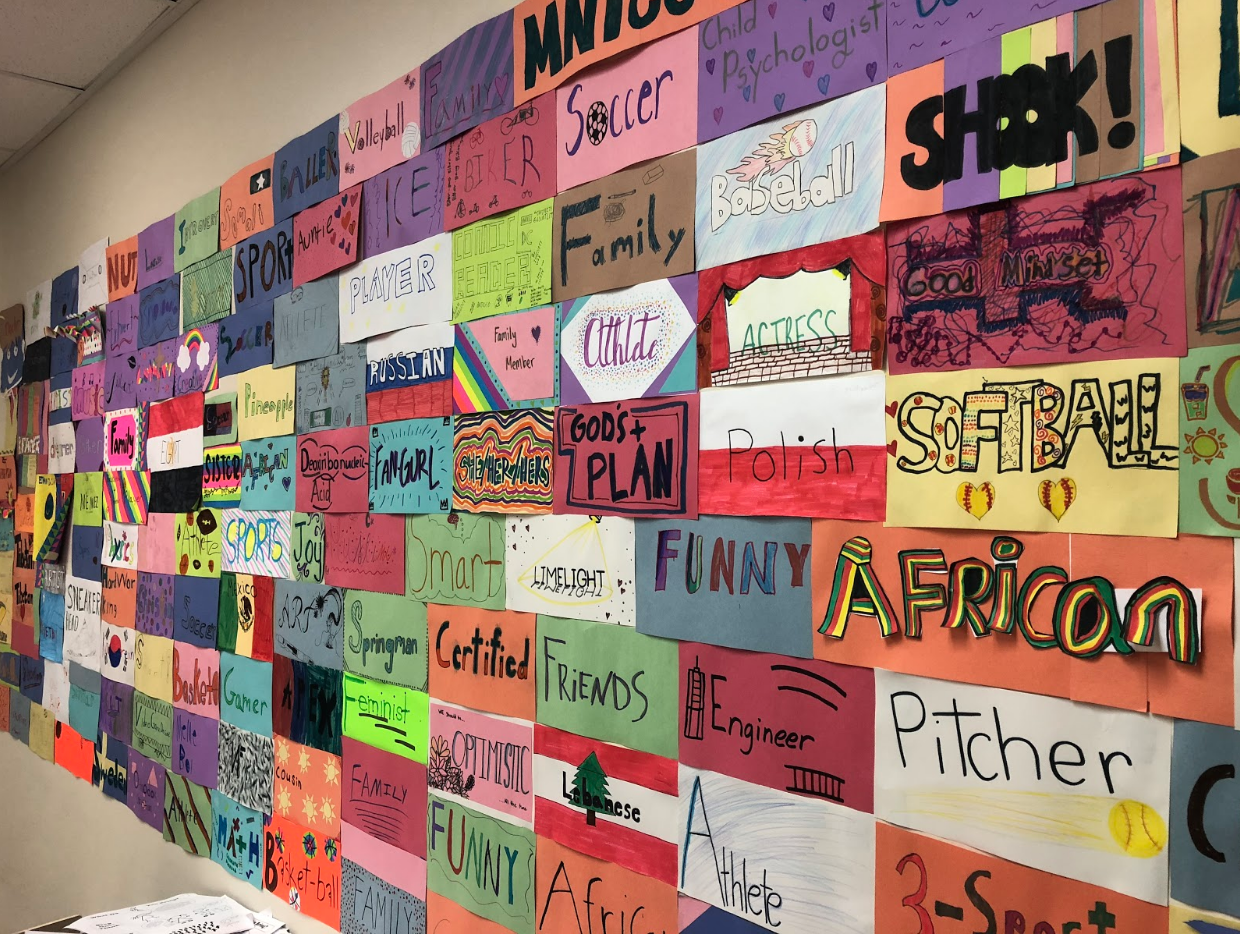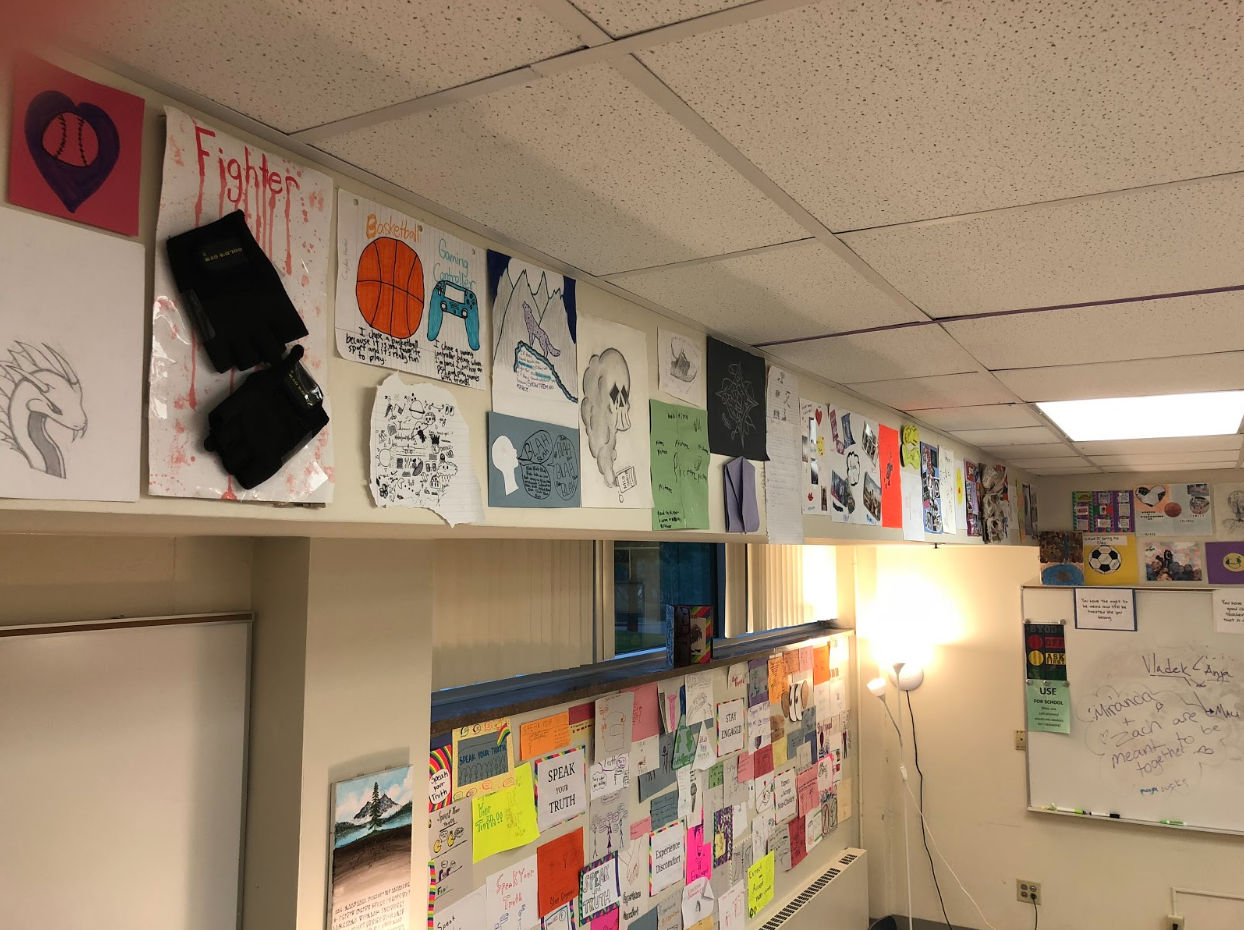
Oct 1, 2018 12:00:00 AM
 I really love my room, and it seems like students do, too. I don’t have a class first hour, but there are always five to 10 kids in here before school hanging out. My desks are old and…desky. I don’t have a lot of room or money for flex seating, and I don’t have the eye or time for Pinterest-worthy bulletin boards. Still, my walls, like my room, are a whole lot better when given to the kids.
I really love my room, and it seems like students do, too. I don’t have a class first hour, but there are always five to 10 kids in here before school hanging out. My desks are old and…desky. I don’t have a lot of room or money for flex seating, and I don’t have the eye or time for Pinterest-worthy bulletin boards. Still, my walls, like my room, are a whole lot better when given to the kids.
 I am absurdly proud of my classroom library. When I moved into my new classroom last fall, the library was suffering badly from being out-of-date and almost entirely full of White writers. In one year, I have done a whole bunch of stuff to bring the collection to where it is now. I’m not done, not by a long-shot, but my collection now includes many books by people of color and indigenous writers. I’ve always believed in the power of diverse reading choices, but this year I’ve been especially aware of how important it is to my students. I have a ton of graphic novels and superhero comics, and have started to add books in some of the languages spoken by my students that are not English. My students from Tibet and Haiti have been so happy to see books by and about their people.
I am absurdly proud of my classroom library. When I moved into my new classroom last fall, the library was suffering badly from being out-of-date and almost entirely full of White writers. In one year, I have done a whole bunch of stuff to bring the collection to where it is now. I’m not done, not by a long-shot, but my collection now includes many books by people of color and indigenous writers. I’ve always believed in the power of diverse reading choices, but this year I’ve been especially aware of how important it is to my students. I have a ton of graphic novels and superhero comics, and have started to add books in some of the languages spoken by my students that are not English. My students from Tibet and Haiti have been so happy to see books by and about their people.
 I had a student walk down from the high school this week, looking to borrow a copy of “The Hate U Give.” I started the year with 15 on my shelf and was already down to my last two. I don’t know her name, but she left with a book. I’m not all that worried about getting it back. By far, the books are the most expensive part of my room, made more so by my not having any sort of book check-out system and encouraging students to take books that seem interesting to them. I’ve written some grants in the last year that have helped out, have sought donations through a constantly updated Amazon wishlist, and have made some money through writing that I’ve often used to buy every book I can that my students may enjoy. Also, these pictures are from before school started. The library is now a well-used mess and it is perfect. Now, let me show you how our first week together went down.
I had a student walk down from the high school this week, looking to borrow a copy of “The Hate U Give.” I started the year with 15 on my shelf and was already down to my last two. I don’t know her name, but she left with a book. I’m not all that worried about getting it back. By far, the books are the most expensive part of my room, made more so by my not having any sort of book check-out system and encouraging students to take books that seem interesting to them. I’ve written some grants in the last year that have helped out, have sought donations through a constantly updated Amazon wishlist, and have made some money through writing that I’ve often used to buy every book I can that my students may enjoy. Also, these pictures are from before school started. The library is now a well-used mess and it is perfect. Now, let me show you how our first week together went down.
 I only really have four rules in my room, and I stole them from The Pacific Education Group’s protocol for
Courageous Conversations. On the very first day of school, I introduce those four rules to the students and we talk about what they mean, and how they make my classroom a little different. For example, one of the rules is “Stay Engaged.” I ask them who likes to draw in class, and a bunch of kids raise their hands. Then, I ask them how many students know that drawing helps them pay attention, and about half keep their hands up. So, I explain, if I made a rule like “No Drawing in Class,” I’d be hurting half of you and helping half of you. If the rule is, instead, “Stay Engaged,” then you can do whatever that means for you to be engaged. For some, staying engaged means drawing, for some not. Some may stay engaged by responding verbally to me or their classmates, and some may need to stay quiet. I had a student a few years back who was most engaged in my class when she was able to do handstands against the wall on the side of the room. OK. The other rules work pretty much the same way: “Speak Your Truth,” “Experience Discomfort” and “Expect/Accept Non-Closure.” We talk about how
your truth rather than
the truth is important because it opens up the conversation to multiple perspectives. I explain that I want them to lean into discomfort, whether that means a challenging conversation or focusing on skills and subjects they struggle with, but I don’t ever want them to feel unsafe or unwelcome. I let them know we will often leave discussions half finished at the bell. And we will not, no matter how hard we work, fix everything in the world this year, but we can be happy at any ground we gain. I don’t really talk that long. I hope I don’t. Mainly, we get the ideas out there, and then students make little signs to hang up around the four rules, or agreements. We talk about how it looks and feels for them to do those things. They go up the night of the first day and hang there the rest of the year for easy reference.
I only really have four rules in my room, and I stole them from The Pacific Education Group’s protocol for
Courageous Conversations. On the very first day of school, I introduce those four rules to the students and we talk about what they mean, and how they make my classroom a little different. For example, one of the rules is “Stay Engaged.” I ask them who likes to draw in class, and a bunch of kids raise their hands. Then, I ask them how many students know that drawing helps them pay attention, and about half keep their hands up. So, I explain, if I made a rule like “No Drawing in Class,” I’d be hurting half of you and helping half of you. If the rule is, instead, “Stay Engaged,” then you can do whatever that means for you to be engaged. For some, staying engaged means drawing, for some not. Some may stay engaged by responding verbally to me or their classmates, and some may need to stay quiet. I had a student a few years back who was most engaged in my class when she was able to do handstands against the wall on the side of the room. OK. The other rules work pretty much the same way: “Speak Your Truth,” “Experience Discomfort” and “Expect/Accept Non-Closure.” We talk about how
your truth rather than
the truth is important because it opens up the conversation to multiple perspectives. I explain that I want them to lean into discomfort, whether that means a challenging conversation or focusing on skills and subjects they struggle with, but I don’t ever want them to feel unsafe or unwelcome. I let them know we will often leave discussions half finished at the bell. And we will not, no matter how hard we work, fix everything in the world this year, but we can be happy at any ground we gain. I don’t really talk that long. I hope I don’t. Mainly, we get the ideas out there, and then students make little signs to hang up around the four rules, or agreements. We talk about how it looks and feels for them to do those things. They go up the night of the first day and hang there the rest of the year for easy reference.





Tom Rademacher (Mr. Rad to his students) is an English teacher in Minneapolis, Minnesota. In 2014 he was named Minnesota Teacher of the Year. He teaches writing and writes about teaching on his blog. His book, published by University of Minnesota Press, is called "IT WON’T BE EASY: An Exceedingly Honest (and Slightly Unprofessional) Love Letter to Teaching."
Few issues in education spark more tension and debate than standardized testing. Are they a tool for equity or a burden on students? A necessary check on school systems or a flawed measure of...
Charter schools are public schools with a purpose. Operating independently from traditional school districts, they're tuition-free, open to all students, and publicly funded—but with more flexibility...
Despite the benefits of a diverse teaching force, prospective teachers of color fall out of our leaky preparation pipeline at every stage: preparation, hiring, induction, and retention. Here’s what...
Ed Post is the flagship website platform of brightbeam, a 501(c3) network of education activists and influencers demanding a better education and a brighter future for every child.
© 2020-2025 brightbeam. All rights reserved.
Leave a Comment